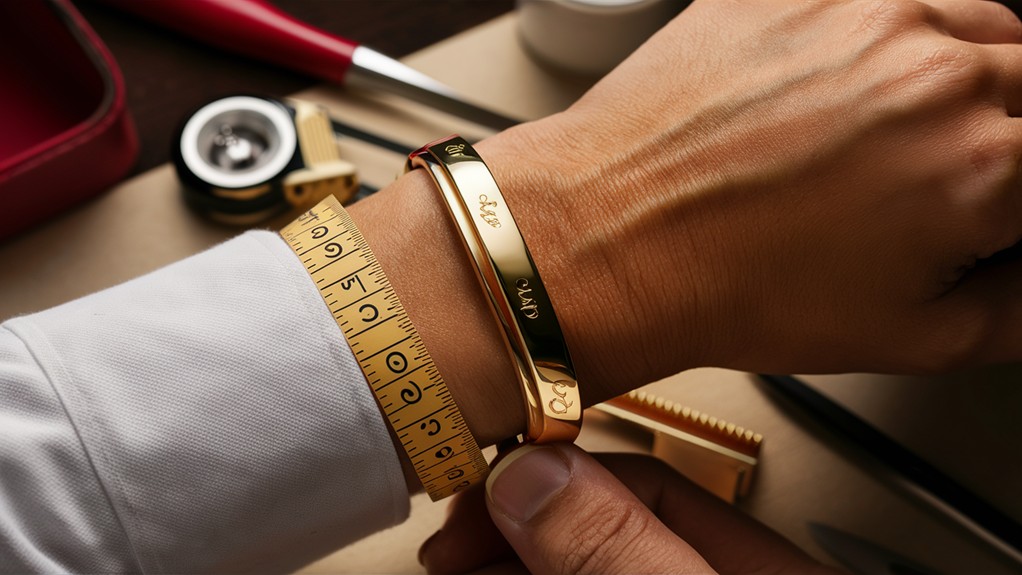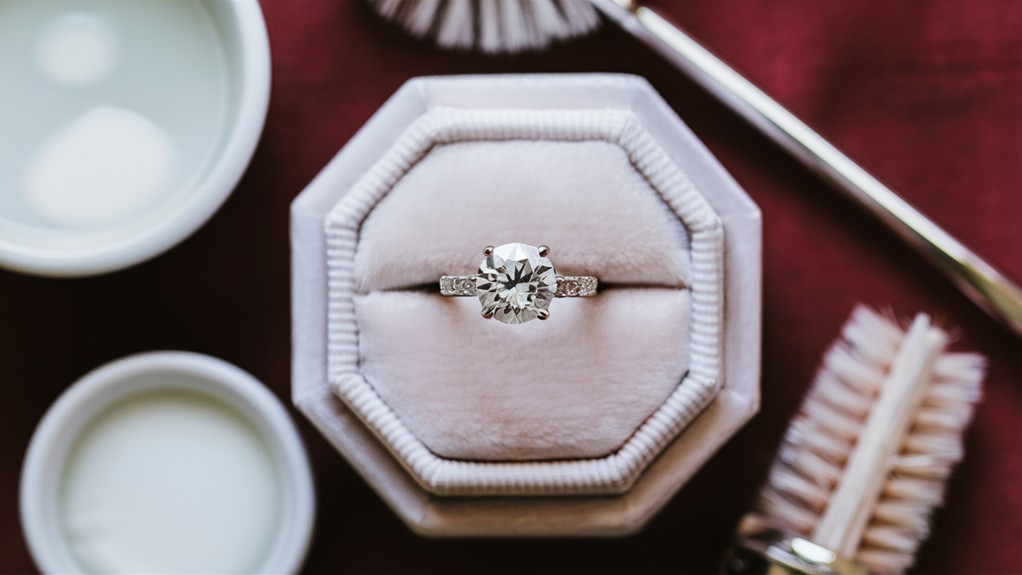When you slip on that eye-catching costume necklace or those trendy faux earrings, you might not realize the potential risks lurking beneath their sparkle. Fake jewelry can be a stylish and affordable way to accessorize, but it can likewise lead to uncomfortable and sometimes serious skin reactions. If you've ever experienced itching, redness, or swelling after wearing costume pieces, you're not alone. Understanding the causes of these reactions and learning how to prevent them is essential for anyone who loves to adorn themselves with fashionable, budget-friendly jewelry. So, how can you safely indulge in your passion for costume pieces without compromising your skin's health?
Our Highlighted Points
- Choose hypoallergenic materials like surgical stainless steel, titanium, or 18k gold to minimize allergic reactions.
- Apply clear nail polish to metal parts of costume jewelry to create a protective barrier against allergens.
- Clean jewelry regularly with mild soap and water to remove potential irritants and reduce skin reactions.
- Conduct patch tests before wearing new costume pieces to identify potential allergic reactions.
- Limit wear time and avoid moisture-inducing activities to reduce the risk of skin irritation from costume jewelry.
Understanding Costume Jewelry Allergies
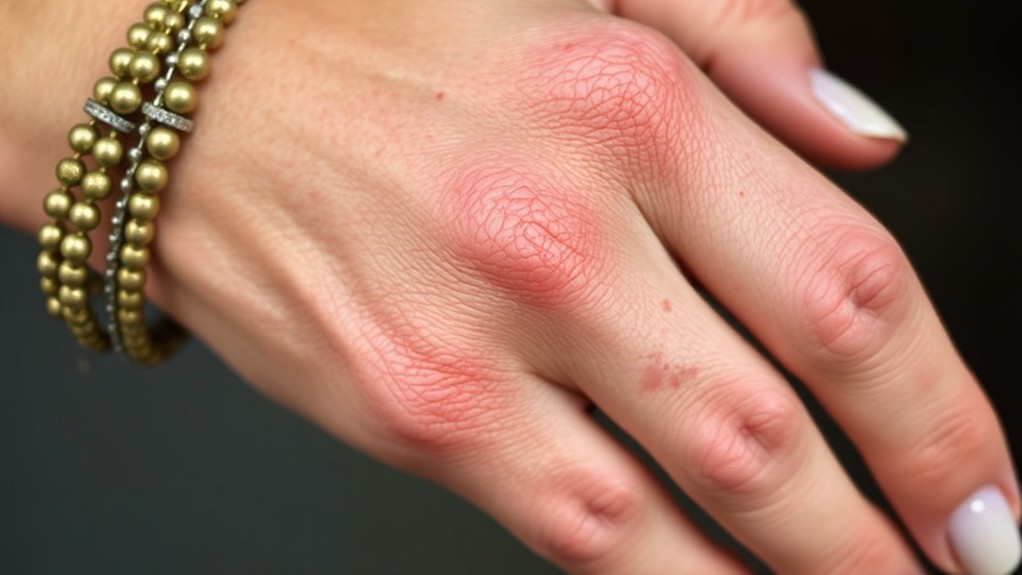
Costume jewelry, while fashionable and affordable, can be a hidden source of discomfort for many wearers. If you've experienced redness, itching, or swelling after donning your favorite statement piece, you may be dealing with jewelry allergies.
These reactions, affecting approximately 10% of the U.S. population, are often triggered by common metals found in costume jewelry, such as nickel and cobalt.
Understanding metal allergies is essential for preventing jewelry rashes. Symptoms can appear within hours of contact and may worsen with repeated exposure. Those with a history of metal allergies are particularly susceptible, potentially experiencing more severe reactions like bumpy skin, burning sensations, and scaling.
To minimize the risk of allergic reactions:
- Opt for hypoallergenic jewelry made from stainless steel, titanium, or 18k gold.
- Apply a clear nail polish barrier to metal parts of jewelry, creating a protective layer between your skin and potential allergens.
- Be aware of early signs of skin reactions and remove jewelry promptly if symptoms occur.
- Consider patch testing before wearing new costume pieces for extended periods.
Common Allergens in Fake Jewelry
While understanding allergies to costume jewelry is important, it's likewise valuable to know the specific culprits behind these reactions. Common allergens in fake jewelry include nickel, cobalt, chromium, and brass. These metals are frequently used in costume jewelry because of their durability and cost-effectiveness.
Nickel allergies are the most prevalent, affecting approximately 10% of the U.S. population. Even gold and silver pieces may contain trace amounts of these allergens, as they're often added to improve durability. When your skin comes into contact with these metal parts, particularly during prolonged exposure, you may experience a jewelry allergy or contact dermatitis.
Symptoms of a skin reaction can include:
- Redness
- Itching
- Swelling
- Blistering at contact sites
These symptoms typically appear within hours of exposure. To prevent a jewelry rash, consider opting for hypoallergenic jewelry made from materials such as surgical stainless steel or titanium.
These alternatives considerably reduce the risk of allergic reactions, allowing you to enjoy wearing costume jewelry without compromising your skin's health.
Recognizing Allergic Reaction Symptoms
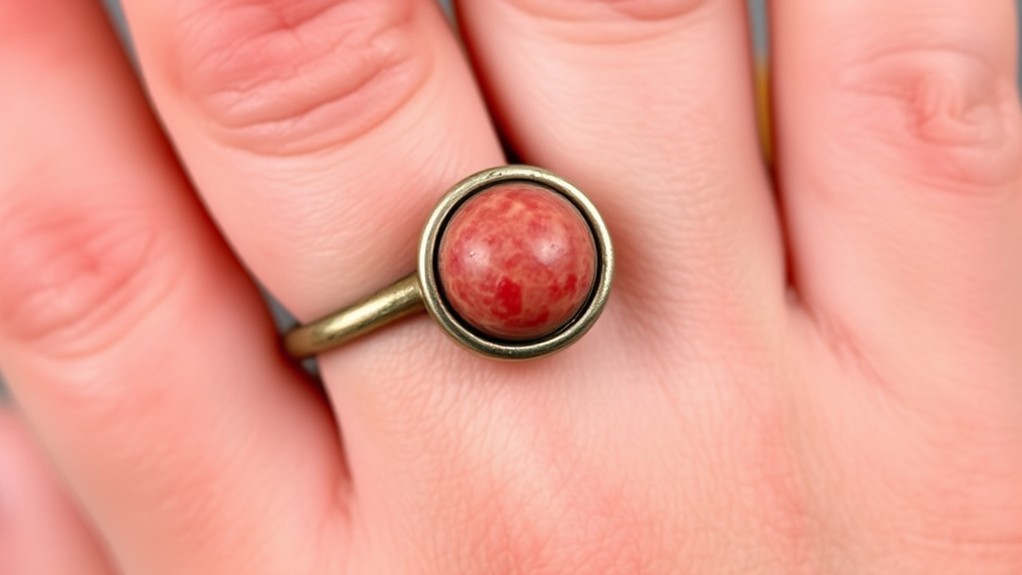
Many people wear costume jewelry without realizing they're having an allergic reaction.
Contact dermatitis, a common skin condition caused by exposure to allergens like nickel in fake jewelry, can appear in different ways.
To recognize symptoms of an allergic reaction, pay attention to your skin's response after wearing costume pieces:
- Redness and itching at the contact site
- Swelling or inflammation of the affected area
- Blistering or formation of small, fluid-filled bumps
- Dry, scaly, or bumpy skin texture
These symptoms often appear within hours of exposure and may worsen with repeated contact.
Even though you've worn jewelry for years without issue, you can develop a jewelry rash at any time.
If you notice these signs:
- Remove the jewelry right away to prevent further irritation
- Clean the affected area with mild soap and water
- Apply a cool compress to reduce inflammation
- Monitor the reaction for improvement
If symptoms persist beyond one week or worsen, consult a dermatologist for professional evaluation and treatment.
Choosing Hypoallergenic Costume Pieces
If you're prone to skin reactions from jewelry, choosing hypoallergenic costume pieces is crucial for your comfort and safety. When selecting hypoallergenic jewelry, opt for materials like surgical stainless steel, titanium, or 18k gold. These metals are less likely to cause allergic reactions and are suitable for sensitive skin.
To further reduce the risk of irritation:
- Look for nickel-free or low-nickel options, as nickel is a common allergen in costume jewelry.
- Conduct a patch test before regular use by wearing the new piece for a day to check for any adverse reactions.
- Apply a barrier method, such as clear nail polish, to metal parts that come into contact with your skin.
- Clean your jewelry regularly to remove dirt and bacteria that can intensify skin irritation.
- Avoid wearing costume pieces during activities that induce moisture, as this can increase the likelihood of a reaction.
Protective Measures for Skin Safety
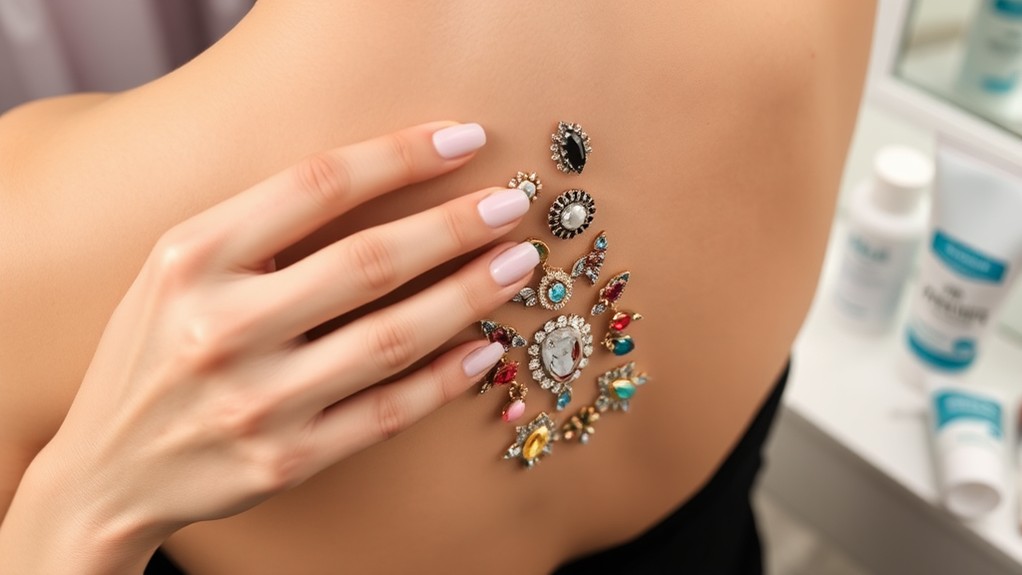
A shield between your skin and costume jewelry can make all the difference in preventing allergic reactions and irritation. To protect yourself from potential metal allergies and jewelry rash, apply a thin layer of clear nail polish on metal parts that come into direct skin contact. This creates a barrier against common allergens like nickel and cobalt.
Choose hypoallergenic jewelry made from materials such as stainless steel, titanium, or 18k gold to reduce the risk of allergic reactions. Limit wear time, especially during activities that induce moisture, to minimize skin irritation.
Before regular use, conduct a patch test by wearing a piece for a day to check for adverse skin reactions. If you experience any symptoms of irritation, such as redness or itching, remove the jewelry immediately and consider consulting a dermatologist if symptoms persist.
| Material | Allergenic Potential | Recommended Use |
|---|---|---|
| Nickel | High | Avoid |
| Titanium | Low | Ideal |
| 18k Gold | Low | Safe |
Proper Care of Costume Jewelry
Maintaining your costume jewelry isn't just about keeping it shiny; it's crucial for your skin's health too. To reduce skin reactions and prolong the life of your accessories, follow these care instructions:
- Regularly clean your costume jewelry using mild soap and water. This removes dirt, oil, and bacteria that can cause skin irritation.
- Store properly in a dry, cool place to prevent moisture-related damage and minimize the risk of skin reactions.
- Apply a thin layer of clear nail polish on metal parts to create a protective barrier against skin contact and allergic reactions.
- Limit wear time, especially during activities that induce sweating, to reduce the chance of skin irritation.
- Choose hypoallergenic materials, such as surgical stainless steel or titanium, when purchasing costume jewelry.
Treatment Options for Skin Reactions
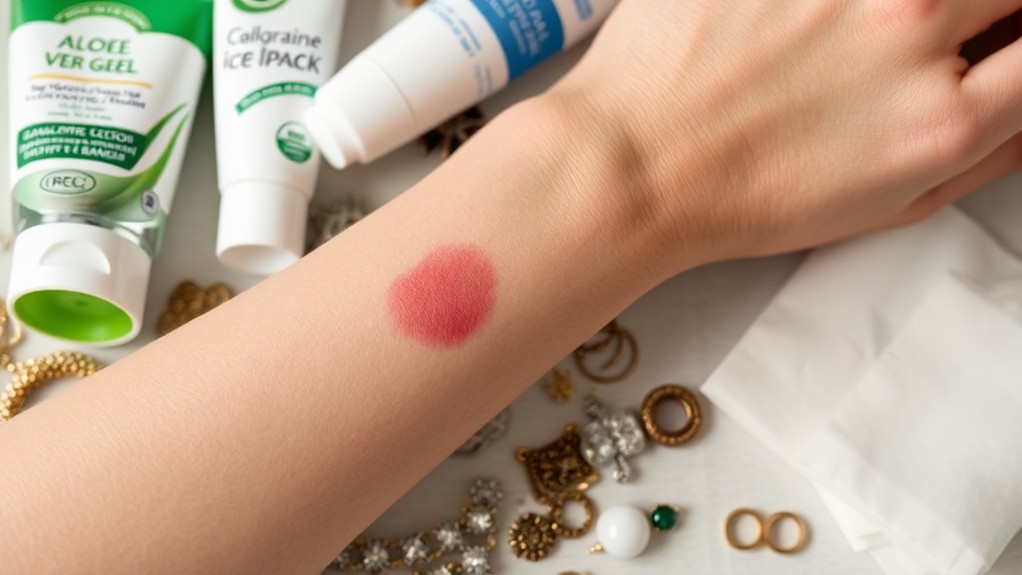
While proper care can prevent many issues, skin reactions to costume jewelry sometimes occur.
If you experience symptoms, immediate removal of the offending jewelry is essential to prevent further irritation. To ease discomfort, consider the following treatment options:
- Topical treatments:
- Apply over-the-counter ointments, such as antihistamine or corticosteroid creams, to reduce itching and inflammation.
- Use anti-itch creams to soothe the affected area.
- Emollient creams can moisturize and promote healing.
- Barrier methods:
- Apply clear nail polish to metal parts of jewelry to create a protective layer between your skin and potential allergens.
- Consider switching to hypoallergenic jewelry to minimize future reactions.
- Professional consultation:
- If symptoms persist beyond one week or worsen, consult a dermatologist for evaluation and advanced treatment options.
Long-Term Allergy Management Strategies
To effectively manage jewelry allergies long-term, you'll need to adopt an all-encompassing strategy. This approach involves several key components:
- Material Selection:
- Choose hypoallergenic jewelry made from surgical stainless steel or titanium
- Avoid nickel alloys, a common trigger for contact dermatitis
- Protective Measures:
- Apply clear nail polish to metal parts of jewelry
- Create a barrier between your skin and potential allergens
- Allergen Identification:
- Undergo allergy testing to pinpoint specific sensitivities
- Tailor your jewelry selection based on test results
- Symptom Management:
- Use over-the-counter ointments and topical treatments for flare-ups
- Apply antihistamine or corticosteroid creams as needed
- Professional Guidance:
- Seek consultation with allergy specialists
- Investigate long-term immunotherapy options
- Avoidance Strategies:
- Limit the time your skin comes into contact with jewelry
- Consider avoiding wearing jewelry during high-risk activities
Alternative Materials for Sensitive Skin

For those with sensitive skin, finding the right jewelry materials is key to avoiding allergic reactions. Nickel allergies, affecting about 10% of the U.S. population, make it vital to choose hypoallergenic alternatives when selecting costume jewelry.
To minimize the risk of irritation and allergic reactions, opt for pieces made from surgical stainless steel, titanium, or 18k gold.
When shopping for jewelry, look for items labeled as "nickel-free" or "hypoallergenic." Sterling silver and platinum are likewise safer choices compared to cheaper metal alloys commonly found in costume jewelry.
If you're unsure about a piece, conduct a patch test by wearing it for a day to identify potential sensitivities.
To guarantee jewelry safety for sensitive skin:
- Choose surgical-grade or hypoallergenic materials
- Avoid costume jewelry containing metal alloys with nickel or cobalt
- Select alternative materials like titanium or 18k gold
- Consider sterling silver or platinum for their lower irritation potential
- Always perform a patch test before committing to long-term wear
Frequently Asked Questions
How to Get Rid of Artificial Jewellery Allergy?
To get rid of artificial jewelry allergy, remove the offending piece immediately. Clean the affected area with mild soap and water. Apply over-the-counter corticosteroid creams or antihistamines to reduce symptoms. Switch to hypoallergenic materials for future wear.
What Happens When You're Allergic to Fake Jewelry?
If you're allergic to fake jewelry, you'll likely experience skin reactions like redness, itching, and swelling where the jewelry touches your skin. You might develop a rash within hours of wearing it, causing discomfort and irritation.
How Do You Keep Costume Jewelry From Turning Your Skin Green?
To prevent green skin from costume jewelry, you'll want to choose hypoallergenic materials, apply clear nail polish to the jewelry, avoid moisture exposure, clean it regularly, and limit wear time. These steps help reduce metal reactions with your skin.
How to Make Your Jewelry Hypoallergenic?
To make your jewelry hypoallergenic, opt for materials like surgical stainless steel, titanium, or 18k gold. Apply a clear barrier, like nail polish, to metal parts. Choose nickel-free pieces and conduct patch tests before extended wear.

